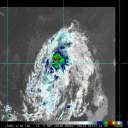Show Selection:
|
#1017169 (Received by flhurricane at: 10:45 AM 16.Sep.2020)
TCDAT2
Post-Tropical Cyclone Paulette Discussion Number 39
NWS National Hurricane Center Miami FL AL172020
1100 AM AST Wed Sep 16 2020
Conventional GOES-16 visible and enhanced BD-curve satellite imagery
show that Paulette has merged with the large baroclinic zone
extending over the north-central Atlantic. Deep convection just to
the north of the surface center that was noted on earlier microwave
images has dissipated. Therefore, the system is now classified as
extratropical cyclone and this is the last NHC advisory. The initial
intensity is conservatively lowered to 75 kt based on 1221 UTC
scatterometer data, earlier Dvorak intensity estimates and a SATCON
analysis of 64 kt.
The NHC intensity forecast is based on a blend of the global models
and is just above the HCCA multi-model consensus. Although not
specified in the NHC forecast, there is some chance that Paulette
could reacquire tropical or subtropical characteristics later this
week or over the weekend when it turns southward back over warmer
oceanic temperatures. This possibility will be monitored for
inclusion in future Tropical Weather Outlooks, if necessary.
The post-tropical cyclone`s initial motion is east-northeastward,
or 060/30 kt. The low is expected to continue quickly in this
general motion through Thursday morning within the deep-layer
mid-latitude flow. By mid-period, Post-Tropical Paulette is
expected to slow down and turn southeastward to southward as it
moves on the west side of mid- to upper-level low to the east of the
cyclone. The new track forecast is based primarily on the HCCA and
TVCA consensus aids.
Paulette is producing a large area of high seas. The maximum seas
estimated by the Ocean Prediction Center near the core of the
hurricane are up to 50 feet. Swells from Post-Tropical Cyclone
Paulette have spread far away from the center and continue to affect
Atlantic Canada, Bermuda, and portions of the U.S. east coast.
This is the last NHC advisory on Paulette. Additional information
on this system can be found in High Seas Forecasts issued by the
National Weather Service, under AWIPS header NFDHSFAT1, WMO header
FZNT01 KWBC, and online at ocean.weather.gov/shtml/NFDHSFAT1.php
FORECAST POSITIONS AND MAX WINDS
INIT 16/1500Z 43.3N 45.2W 75 KT 85 MPH...POST-TROP/EXTRATROP
12H 17/0000Z 45.0N 39.9W 60 KT 70 MPH...POST-TROP/EXTRATROP
24H 17/1200Z 46.2N 35.3W 50 KT 60 MPH...POST-TROP/EXTRATROP
36H 18/0000Z 45.1N 33.1W 40 KT 45 MPH...POST-TROP/EXTRATROP
48H 18/1200Z 42.5N 32.5W 35 KT 40 MPH...POST-TROP/EXTRATROP
60H 19/0000Z 39.5N 32.5W 35 KT 40 MPH...POST-TROP/EXTRATROP
72H 19/1200Z 37.0N 32.7W 35 KT 40 MPH...POST-TROP/EXTRATROP
96H 20/1200Z 35.0N 32.9W 35 KT 40 MPH...POST-TROP/EXTRATROP
120H 21/1200Z 34.0N 32.4W 35 KT 40 MPH...POST-TROP/EXTRATROP
$$
Forecaster Roberts |



